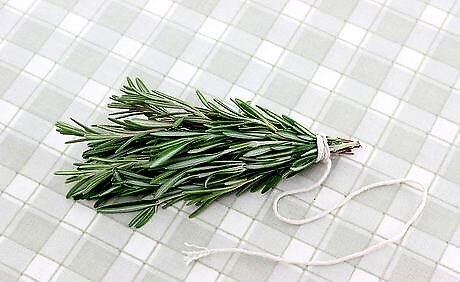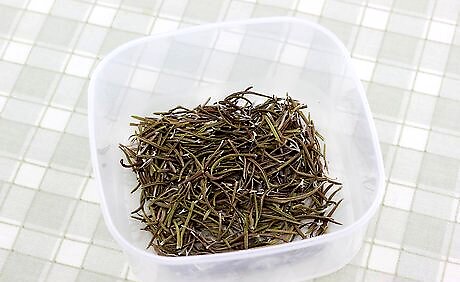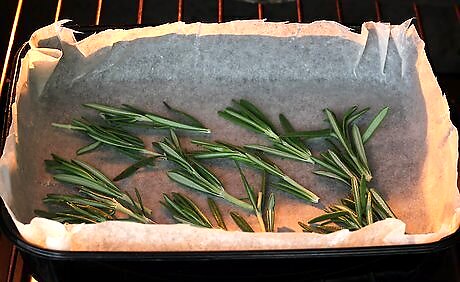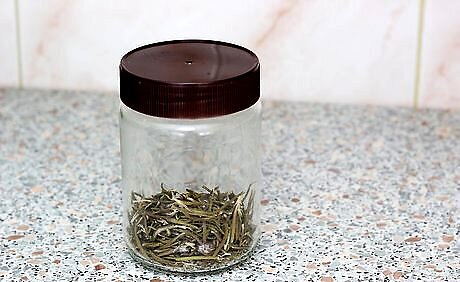
views
Using the Hanging Method

Use scissors to snip sprigs of rosemary off the plant. The best time to harvest your rosemary is in the morning, after the sun has dried away any nighttime dew. Your rosemary plant will bush out with vigorous growth from the places where you pinched or snipped it.Dry Rosemary Step 1Bullet1.jpg Try to snip straight sprigs, all about the same length, for easier bundling.Dry Rosemary Step 1Bullet2.jpg

Tie the sprigs into bundles, wrapping twine around the bases of the sprigs. Leave a loop on the twine bundle to make hanging your rosemary sprigs easier. Alternatively, you can use rubber bands to secure your rosemary bundles.Dry Rosemary Step 2Bullet1.jpg You can combine up to eight sprigs of rosemary per bundle.Dry Rosemary Step 2Bullet2.jpg

Hang the rosemary sprigs in a cool, dry and well-ventilated place to dry. Although you can dry your rosemary outdoors, the National Center for Home Food Preservation recommends drying rosemary indoors for the best color and flavor. Your porch, attic, or storage cupboard are all good drying options. You can try hanging the rosemary bundles from a clothes hanger, if this is more convenient.Dry Rosemary Step 3Bullet1.jpg Some people also recommend covering your rosemary with brown paper bags as it dries. This prevents any dust from settling on the rosemary as it dries and also stops any sunlight from bleaching out the color. Just be sure to tear holes in the paper bags to keep the rosemary well ventilated.Dry Rosemary Step 3Bullet2.jpg

Turn the drying rosemary sprigs every day or two to ensure even drying. You'll know the rosemary is dry when all traces of pliability are gone from both stems and leaves. This should take approximately two weeks. You can also spread your rosemary sprigs or bundles on a flat or slanted window screen, elevated on cinder blocks or wooden blocks, for the best air circulation as they dry.Dry Rosemary Step 4Bullet1.jpg You won't be able to hang-dry rosemary sprigs in a humid environment, so you may need to dry your rosemary in the oven or in a food dehydrator.Dry Rosemary Step 4Bullet2.jpg

Store the dried rosemary. Once the rosemary has completely dried, place it on a sheet of waxed paper and separate the tough, woody stems from the leaves. Store in an air-tight container in your kitchen cupboard. Use your dried rosemary in recipes such as lamb roasts and stews, garlic and herb bread, and rosemary-infused oil and butter.
Using the Oven

Prepare the rosemary. Rinse the rosemary well in cold water to remove any remaining dirt or debris. Pat dry with paper towel or use a salad spinner to remove moisture. Pick off any withered leaves or woody stems.

Spread the rosemary on a baking sheet. Place the rosemary - cut into ⁄4 inch (0.6 cm) sprigs - onto a baking sheet lined with parchment paper. Do not overcrowd.

Place in the oven. Place the baking sheet onto the top shelf of an oven preheated to the lowest temperature. Leave to bake for 2 - 4 hours, until the stems of the rosemary are brittle.

Transfer the rosemary to a storage jar. Once out of the oven, leave the rosemary to cool completely. Gather up the edges of the parchment paper to form a funnel and slide the dried rosemary into a clean glass jar. Seal the jar tightly and store in a dry, dark place, such as your kitchen cupboard.
Using a Food Dehydrator

Prepare the rosemary. Rinse the rosemary and shake or blot it dry, or use a salad spinner to remove excess moisture.

Spread the rosemary onto dehydrator trays. Run the dehydrator at a low heat setting (between 95 and 105 degrees Fahrenheit, or 35 and 40.5 degrees Celsius) until the rosemary stems break when bent. Herbs that are more delicate crumble when dry, but rosemary leaves are more likely to break, much like the stems. The exact amount of time it takes to dry rosemary using this method will vary, but on average, it takes about 6 to 8 hours at 95 degrees Fahrenheit (35 degrees Celsius).

Store in a clean, glass jar. Transfer the dried rosemary to a clean, glass jar and seal tightly. Store in a dry, dark cupboard.



















Comments
0 comment